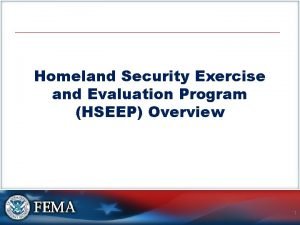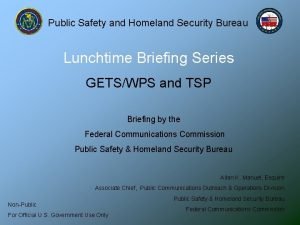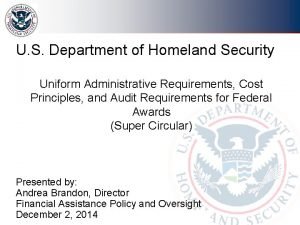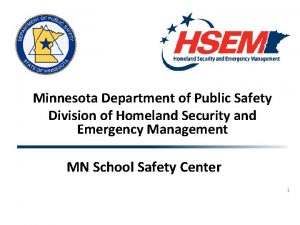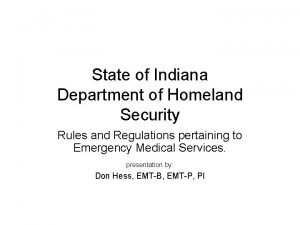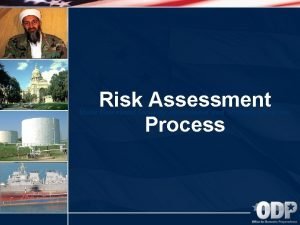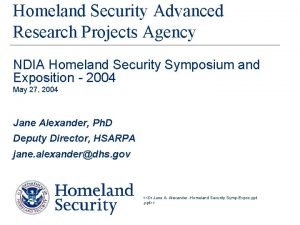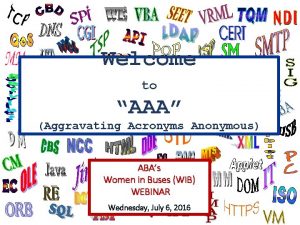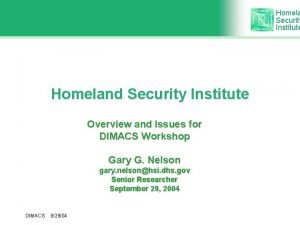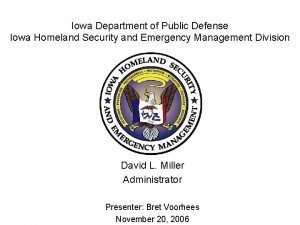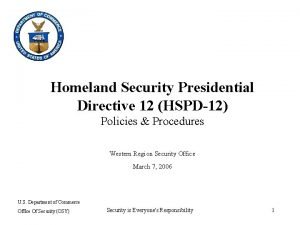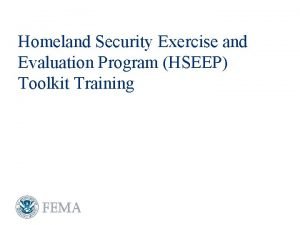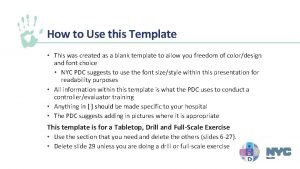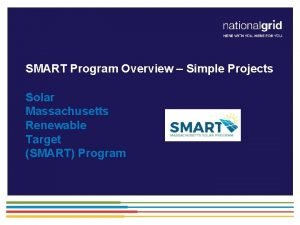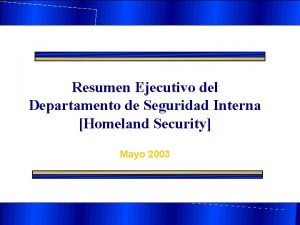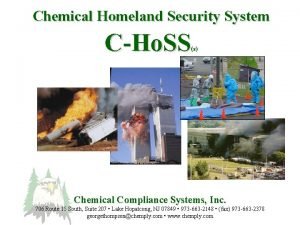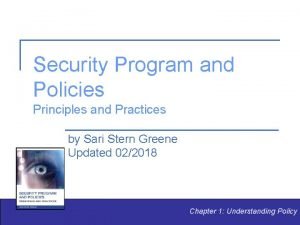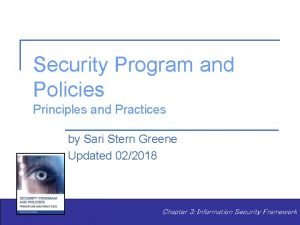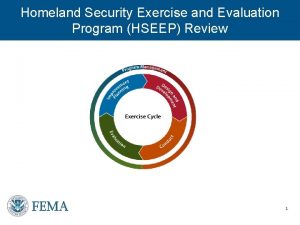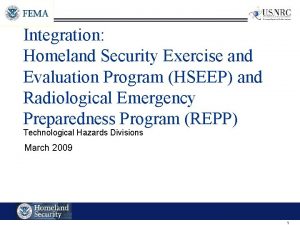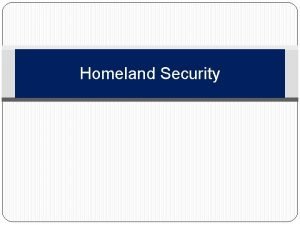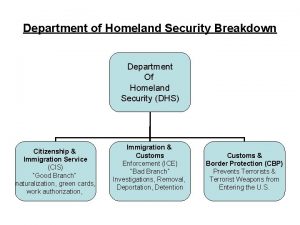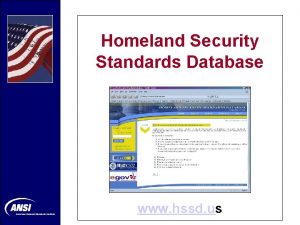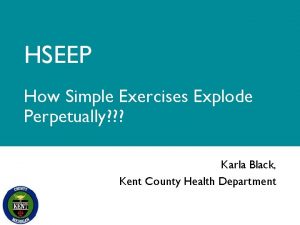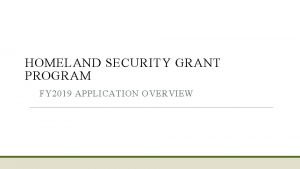Homeland Security Exercise and Evaluation Program HSEEP Overview










































- Slides: 42

Homeland Security Exercise and Evaluation Program (HSEEP) Overview 1

Traditional HSEEP Course Topics Session One • Introduction and HSEEP Fundamentals • Exercise Program Management Session Two • Exercise Design and Development • Exercise Conduct Session Three • Exercise Evaluation • Exercise Improvement Planning

Enabling Objectives § Describe the program and project management concepts of HSEEP. § Describe steps that may be required to complete the respective exercise tasks. § Identify the five major phases to complete an exercise. § Describe tasks in each phase.

HSEEP Purpose The Homeland Security Exercise and Evaluation Program (HSEEP) provides a set of guiding principles for exercise programs, as well as a common approach to exercise program management, design and development, conduct, evaluation, and improvement planning.

HSEEP Program § Standardizes exercise design, development, conduct, and evaluation. § Establishes a common language. § Meets the National Response Framework (NRF) and National Incident Management System (NIMS) goals. § Synchronizes exercise schedules across the Nation. § Provides tools and resources.

HSEEP Terminology and Methodology § Exercises allows the jurisdiction personnel: § To train and practice prevention, protection, preparedness, response, and recovery capabilities in a realistic but risk-free environment. § Provide a valuable tool for assessing and improving performance § A consistent terminology and methodology is critical.

HSEEP Guidance • HSEEP Fundamentals • Program Management • Design and Development • Conduct • Evaluation • Improvement Planning

HSEEP Applicability and Scope • Flexible, scalable, adaptable for use by… • Stakeholders across whole community, and • Applicable to exercises for all mission areas: • Prevention • Protection • Mitigation • Response • Recovery

Why Exercise? Provides: § Validation of training § System improvement § Skills Enhancement § Evaluate effectiveness of policies, plans, and procedures. 9

Why Exercise? § Reveal weaknesses and gaps. § Increase or maintain strengths. § Improve coordination, collaboration, and communications. § Clarify roles and responsibilities. § Gain public recognition and support. § Satisfy regulatory requirements. § Meet applicable standards.

Why Exercise? NIMS requires: “Incident management organizations and personnel to participate in realistic exercises…to improve integration and interoperability. ” National Incident Management System, March 2004

Presidential Policy Directive 8 (PPD-8) PPD 8 requires the Secretary of DHS to develop and administer a National Preparedness System which includes exercises. • National Preparedness System • National Preparedness Goal

National Preparedness System Components 1. Identify and Assess Risk 2. Estimate Capability Requirements 3. Building and Sustain Capabilities 4. Plan to Deliver Capabilities 5. Validate Capabilities 6. Review and Update Risks, Tools and Resources

Why Exercise? § Exercises foster successful responses to real life disasters. § It is not a question of “If” but “When. ” § States have regulatory and legal requirements for exercise participation.

Exercise What? § Test the Emergency Plans, Procedures, and Policies. § Assess the emergency and disaster system. § Provide opportunities for improvement.

Exercising Worst Case § Is it necessary for us to exercise worst case? § Cannot realistically exercise total destruction. § People need to know that they can succeed. § Exercise as we will respond. § Test critical systems without breaking the system. § Exercise to improve.

Comprehensive Exercise Program § Annual Training & Exercise Plan Workshop to determine local needs Multi-Year Training, Exercise and Event Plan 2014, 2015, 2016 § Plan is developed § All Exercises will be evaluated at an appropriate level. § After Action reports and Improvement Plans (AAR/IP) to be completed & submitted. Southern Arizona Region Cochise, Pima, Santa Cruz and Yuma Counties, Arizona March 2014

Comprehensive Exercise Program § Short & Long-term program § Short & Long-range goals § Progressively more challenging. § Series of exercises results in improvement over time.

HSEEP Exercise Types § There are seven types of exercises defined within HSEEP, arranged in two categories: § Discussions-based § Operations-based

HSEEP Discussion-based Exercises § Validate current plans, policies, agreements, and procedures through discussions § Develop new plans, policies, agreements, and procedures. § Seminar § Workshop § Tabletop Exercise (TTX) § Games

HSEEP Operations-based Exercises § Validate plans, policies, agreements, and procedures. § Clarify roles and responsibilities, and identify resource gaps. § Drill § Functional Exercise (FE) § Full-Scale Exercises (FSE)

The HSEEP Exercise Process § Five Phases: § Establish the foundation § Design and development § Conduct § Evaluation § Improvement planning

Phase 1: Establish the Foundation § Tasks: § Review existing Plans § Conduct Assessment-Current & Historical § Define exercise Purpose, Scope & Objectives § Select exercise type § Assess capability § Address costs and liabilities § Announce the exercise

Exercise Planning § Exercise type is consistent with the entity's Multi-Year Training and Exercise Plan. § Objectives based on capabilities and critical tasks. § The scenarios based on the entity's risk and vulnerability assessment. § Current & Historical Events 24

Phase 2: Design and Development • Reviewing elected/appointed officials’ guidance, Training and Exercise Plan (TEP), and other factors; • Selecting exercise planning team and developing exercise planning timeline and milestones; • Developing exercise-specific objectives related to targeted core capabilities identified by elected and appointed officials; • Identifying evaluation requirements, identifying EEGs by mission area; • Developing the EEGs and exercise scenario; • Creating documentation; • Coordinating logistics; and • Planning for exercise communication, control and evaluation.

8 Exercise Design Steps 1. Needs assessment 2. Scope 3. Purpose statement 4. Objectives 5. Narrative (Scenario) 6. Major events/minor events 7. Expected actions 8. Messages

1. Assess Needs A needs assessment should begin with a review of the emergency plan and should address: • Hazards—the risks that you are most likely to face and the priority levels of those hazards. • Area(s) most vulnerable. • Functions most in need of rehearsal. • Potential participants (agencies, organizations, departments, personnel). • Past exercises & current events. • Exercise requirements. • Capabilities.

2. Exercise Scope Key elements • Type of Exercise • Participation level - disciplines • Duration • Location • Parameters

3. Purpose Statement The purpose statement is a broad statement of the exercise goal. It focuses and controls the whole exercise. The purpose statement: • Governs the selection of the objectives, which in turn govern subsequent steps. • Clarifies for the chief executive and potential participants why the exercise is being conducted. • Is useful in communicating plans to the media and community leaders.

4. Developing Objectives? Cornerstone of Design, Development, Exercise Conduct & Evaluation § Provide a framework for scenario development § Drive Master Scenario Events List (MSEL) § Guide development of individual organizational objectives § Provide evaluation criteria § Follow SMART Guidelines Lessons Learned Limit the number of objectives to enable exercise conduct, facilitate reasonable scenario design, and adequately support successful completion of the exercise.

Core Target Capabilities HSEEP PHEP • 30 Core Capabilities • 6 Preparedness Domains • Linked to 38 Target Capabilities • 15 Preparedness Capabilities • Originally developed for Terrorism…refined for All Hazards • DHS National Preparedness Guidelines • Ties into DHS National Preparedness Guidelines • Supports 10 Essential Public Health Services HPP • 8 Capabilities • Support ESF #8

Characteristics of Good Objectives

Characteristics of Good Objectives § Clear, concise, focused § Should contain: § Action stated in observable terms. § Conditions under which action will be performed. § Standards of performance. An objective should state who should do what under what conditions, according to what standards

Creation of Performance Objectives

Next Step After identifying capabilities and designing objectives, design an exercise scenario

What is an Exercise Scenario? Provides the backdrop that drives exercise discussion or play. Should be: §Risk-based §Realistic §Challenging Three basic elements §Conditions §Context §Technical details

5. Developing an Exercise Scenario A story of a simulated threat or hazard on which the exercise will focus. Based on organization’s threat/hazard risk assessment Identifies Mission Area(s) targeted and provides Exercise (context) § May be supported by Modeling and Simulation Model – representation of a system within point in time § Simulation – method of implementing performance model(s) over time

How to Develop an Exercise Scenario § Involve local agencies and facilities § Select an appropriate venue. § Use previous real-world incidents, exercises, Standard Operating Procedures and Emergency Operations Plans. § Limit detailed and superfluous information.

6. Write Major and Detailed Events • Developing an exercise scenario is much like writing a play. In developing a play, the playwright organizes events into acts and scenes. Similarly, an exercise designer organizes events into major and detailed events. • Major and detailed events are occurrences�large or small�that take place after and as a result of the emergency described in the narrative. It may be helpful to think of them as problems requiring a realistic action that will meet exercise objectives.

7. List Expected Actions Expected actions are the actions or decisions that you want participants to carry out to demonstrate competence. It is necessary to identify expected actions to: • Write messages. Because the point of the exercise is to get the participants to think and react in certain ways, the script must be carefully developed to ensure that the messages get the planned results. Your list of expected actions will enable you to write effective messages. • Determine what should be evaluated. The exercise evaluation will focus on whether the participants respond appropriately in an emergency. The list of actions will become the core of that evaluation.

8. Prepare Messages are used to communicate detailed events to exercise participants. One message may represent an event, or several messages may be needed to notify the participants of the event. Messages serve one purpose: To evoke a response that is, to cause exercise participants to make decisions and take actions that meet the exercise objectives.

Questions? Visual 2. 42
 Homeland security exercise and evaluation program
Homeland security exercise and evaluation program Homeland security infrastructure program
Homeland security infrastructure program Public safety and homeland security bureau
Public safety and homeland security bureau Homeland security uniform
Homeland security uniform Department of homeland security minnesota
Department of homeland security minnesota Indiana department of homeland security ems
Indiana department of homeland security ems Eku homeland security
Eku homeland security Homeland security vulnerability assessment
Homeland security vulnerability assessment Hsarpa sbir
Hsarpa sbir Homeland security advanced research projects agency
Homeland security advanced research projects agency Homeland security acronym
Homeland security acronym Homeland security
Homeland security Nys department of homeland security
Nys department of homeland security Homeland security institute
Homeland security institute Iowa department of homeland security
Iowa department of homeland security Homeland security presidential directive 12
Homeland security presidential directive 12 Homeland intelligence technologies careers
Homeland intelligence technologies careers Hseep eeg
Hseep eeg Incident resource inventory system
Incident resource inventory system Provate security
Provate security دوره owasp
دوره owasp Android security overview
Android security overview Exercise evaluation guide template
Exercise evaluation guide template Sbic program overview
Sbic program overview Overview on the national tuberculosis elimination program
Overview on the national tuberculosis elimination program Ma smart program overview
Ma smart program overview Slovakia my homeland
Slovakia my homeland Anglo saxon homeland
Anglo saxon homeland Homeland infrastructure foundation-level data
Homeland infrastructure foundation-level data Homeland resumen
Homeland resumen Homeland av club
Homeland av club Homeland
Homeland Homeland
Homeland Slovakia my homeland
Slovakia my homeland A new settlement that keeps close ties to its homeland
A new settlement that keeps close ties to its homeland Plrd grading for security officer
Plrd grading for security officer Cyber security exercise
Cyber security exercise Security program and policies principles and practices
Security program and policies principles and practices Security program and policies principles and practices
Security program and policies principles and practices Security program and policies principles and practices
Security program and policies principles and practices Security program and policies principles and practices
Security program and policies principles and practices Security program and policies principles and practices
Security program and policies principles and practices Wireless security in cryptography
Wireless security in cryptography
